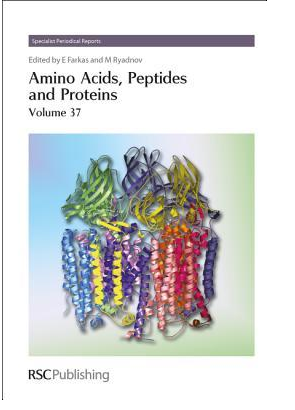
Amino Acids, Peptides and Proteins
[BOOK DESCRIPTION]
Amino Acids, Peptides and Proteins comprises a comprehensive review of significant developments at this biology/chemistry interface. Each volume of this Specialist Periodical Report opens with an overview of amino acids and their applications. Volume 37 marks the return of the series after a five-year hiatus, with Professors Etelka Farkas (Debrecen, Hungary) and Max Ryadnov (National Physical Laboratory, UK) as the new volume editors. There has been considerable progress in the field since the last publication in 2007, and predominantly this volume looks back over the last two year rather than the usual 12-months. However, traditional concepts are also revisited in the context of recent discoveries. Each chapter incorporates current trends of the reviewed topic and the authors' outlook of future perspectives. This is to facilitate the monitoring of the covered areas and their potentianl expansion with the inclusion of other specialist reports in subsequent volume. All chapters are compiled by leading researchers in their subject areas which offers this series as an appealing source of information for the research community in both academia and industry.
[TABLE OF CONTENTS]
Preface v
Etelka Farkas
Maxim Ryadnov
Amino acid and peptide bioconjugates 1 (39)
Nikolett Mihala
Ferenc Hudecz
Introduction 1 (1)
Current trends 1 (1)
1 Amide bond forming reactions 2 (2)
2 Reactions yielding a non-amide bond 4 (18)
3 PEGylation 22 (1)
4 Crosslinking agents 22 (2)
5 Selected applications of 24 (16)
peptide-bioconjugates
References 31 (9)
Self-assembling peptide materials 40 (26)
Shuguang Zhang
1 Introduction 40 (7)
2 General self-assembling peptide 47 (4)
materials
3 Diverse uses of self-assembling peptide 51 (4)
nanofibers
4 Surface modification self-assembling 55 (1)
peptides
5 Lipid-like self-assembling peptide 55 (6)
surfactant materials
6 Summary 61 (5)
References 62 (4)
Metal complexes of amino acids and peptides 66 (53)
Etelka Farkas
Imre Sovago
1 Introduction 66 (2)
2 Amino acid complexes 68 (17)
3 Peptide Complexes 85 (34)
References 105(14)
Model systems for folding and tertiary 119(32)
contacts in peptides: A perspective from
the physical sciences
Jason Crain
1 Introduction 119(1)
2 Thermodynamic basics of liquid mixtures 120(4)
and hydrophobicity
3 Current trends-in what state is the art? 124(7)
4 Model systems for self-organization 131(13)
5 Future perspectives 144(7)
References 146(5)
Protein nanotubes, channels and cages 151(39)
Jonathan G. Heddle
Jeremy R. H. Tame
1 Introduction 151(3)
2 Current trends 154(1)
3 Nanofibres (Amyloid-like fibrils) 155(2)
4 Nanotubes 157(11)
5 Cage proteins 168(10)
6 Channel proteins 178(1)
7 Examples of useful principles and 179(3)
methods
8 Ab initio design 182(1)
9 Future perspective and applications 182(8)
References 183(7)
Prescriptive peptide design 190(48)
Maxim G. Ryadnov
1 Introduction 190(1)
2 Generic considerations for prescriptive 190(4)
peptide design
3 Structural space of de novo design 194(5)
4 Current trends: structural rationales 199(12)
5 Current trends: de novo motifs 211(18)
6 Future perspectives 229(9)
References 230(8)
Targeting alpha-helix based protein 238
interactions; nuclear receptors as a case
study
Lech-Gustav Milroy
Lidia Nieto
Luc Brunsveld
1 Introduction 238(5)
2 Nuclear receptors 243(11)
3 a-Helix-inspired drug discovery 254
Conclusions 265(1)
References 266

 新书报道
新书报道